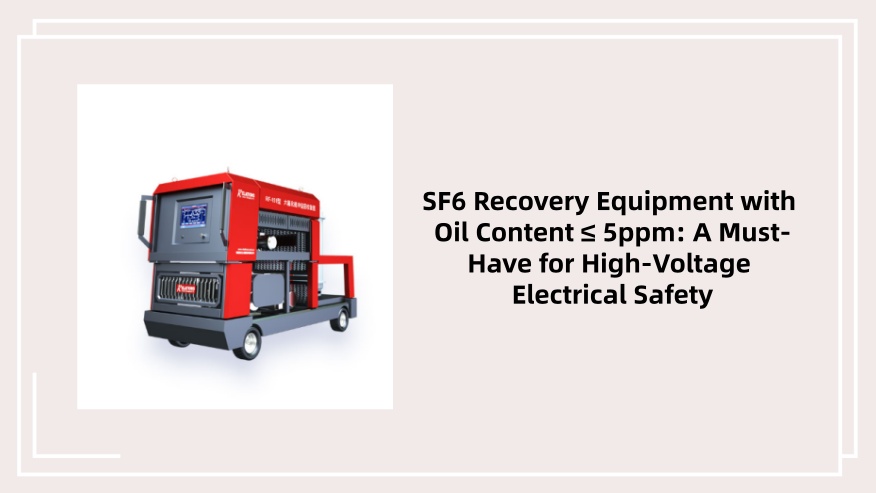
- SF6 Relations
- 2025-09-19
SF6 (sulfur hexafluoride) gas is the backbone of modern high-voltage electrical systems—powering GIS (Gas-Insulated Switchgear), transformers, and circuit breakers with its unmatched insulation and arc-extinguishing capabilities. Yet, this critical gas faces a hidden threat: oil contamination. Even trace amounts of oil can degrade SF6’s performance, leading to equipment corrosion, reduced insulation strength, and costly unplanned downtime. For industries relying on electrical reliability, SF6 recovery equipment with oil content ≤ 5ppm isn’t just a tool—it’s a safeguard against operational failure and environmental non-compliance.
Why Oil Content ≤ 5ppm Matters for SF6 Recovery
Oil impurities in SF6 gas typically stem from equipment leaks (e.g., transformer oil seepage) or improper storage. While small oil concentrations may seem harmless, industry standards like IEC 60480 (the global benchmark for SF6 handling) mandate oil content ≤ 5ppm for recycled or reclaimed SF6. Here’s why this threshold is non-negotiable:
- Insulation Degradation: Oil molecules attach to electrical insulation components, forming a conductive film that lowers dielectric strength. This increases the risk of partial discharge and even catastrophic insulation breakdown in high-voltage equipment.
- Equipment Corrosion: Oil reacts with SF6 byproducts (e.g., HF) to form acidic compounds, accelerating metal corrosion in GIS enclosures and valves.
- Environmental Risks: Oil-contaminated SF6 is harder to recycle, increasing the need for new gas procurement—and SF6 has a global warming potential (GWP) 23,500 times that of CO₂. Equipment that maintains oil content ≤ 5ppm ensures SF6 can be safely reused, cutting emissions and costs.
Key Features of High-Quality SF6 Recovery Equipment with Oil Content ≤ 5ppm
To meet the 5ppm oil content standard, top-tier SF6 recovery equipment integrates advanced technologies tailored to precision and efficiency:
Multi-Stage Filtration Systems:
Leading models use a combination of coalescing filters (to capture liquid oil droplets) and activated carbon filters (to adsorb dissolved oil vapors). This dual-layer design ensures even micro-level oil particles are removed, consistently delivering SF6 with oil content ≤ 3ppm (surpassing the 5ppm threshold for added safety).
Real-Time Oil Content Monitoring:
Built-in oil content analyzers (e.g., laser-based or dielectric sensors) provide continuous data on gas purity. If oil levels approach 5ppm, the system triggers an alert or automatically adjusts filtration, preventing non-compliant gas from re-entering equipment.
High SF6 Recovery Rates:
Premium equipment achieves ≥99% SF6 recovery efficiency, minimizing gas waste. This not only reduces environmental impact but also lowers operational costs by reducing the need to purchase new SF6.
Mobility and Versatility:
Many units are designed for on-site use—compact, trailer-mounted, or portable—making them ideal for 变电站 (substations), wind farms, and industrial facilities. They work with all SF6-containing equipment, from small circuit breakers to large GIS units.
How to Choose the Right SF6 Recovery Equipment with Oil Content ≤ 5ppm
When selecting equipment, focus on factors that align with your operational needs and compliance goals:
- Certification: Ensure the equipment meets international standards (IEC 60480, ANSI/NETA MTS-2023) and local regulations (e.g., EU F-Gas Regulation, U.S. EPA guidelines). Certification guarantees the 5ppm oil content claim is validated.
- Durability and Maintenance: Look for robust construction (e.g., stainless steel filters, corrosion-resistant housings) and easy-to-replace parts. Regular maintenance (filter changes, sensor calibration) is critical to sustaining 5ppm performance.
- After-Sales Support: Choose suppliers that offer training, calibration services, and rapid technical support. A reliable partner ensures your equipment remains compliant and efficient long-term.
Real-World Impact: A Utility Company Case Study
A large Asian utility company recently upgraded its SF6 maintenance fleet to equipment with oil content ≤ 5ppm. Prior to the upgrade, the company struggled with recurring GIS failures—oil content in recycled SF6 often exceeded 10ppm, leading to 3-4 unplanned outages annually. After switching to high-precision recovery equipment:
- Oil content in recycled SF6 stabilized at 2-3ppm, meeting IEC standards.
- GIS downtime dropped by 65%, saving over $200,000 in repair and replacement costs.
- SF6 procurement costs decreased by 18% due to higher recovery rates, reducing the company’s carbon footprint by 22 metric tons annually.
In an era of stricter electrical safety standards and environmental accountability, SF6 recovery equipment with oil content ≤ 5ppm is an essential investment. It protects high-voltage assets from premature failure, reduces operational costs, and ensures compliance with global regulations. For utilities, manufacturing plants, and electrical service providers, choosing the right equipment isn’t just about meeting a threshold—it’s about building a reliable, sustainable electrical infrastructure.
To maximize value, partner with suppliers that prioritize precision, durability, and support. With the right SF6 recovery equipment, you can turn a potential risk (oil contamination) into a competitive advantage (enhanced reliability and sustainability).
Leave a Reply